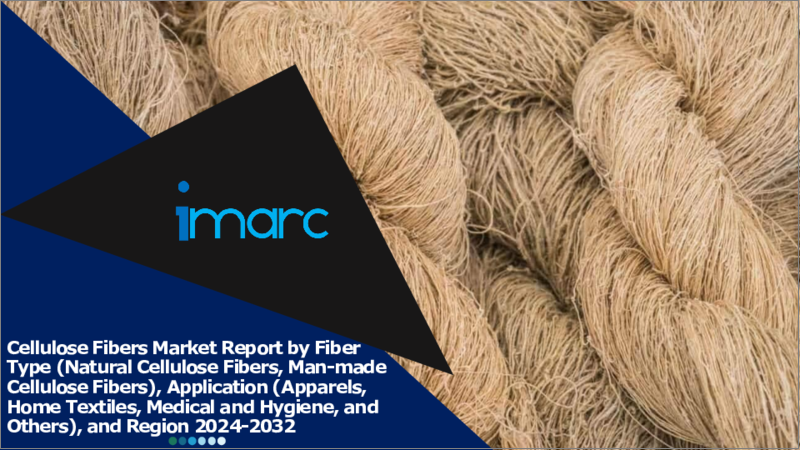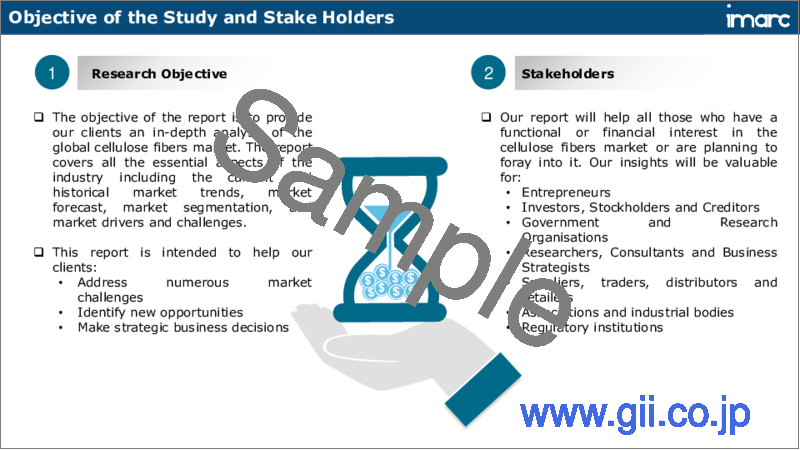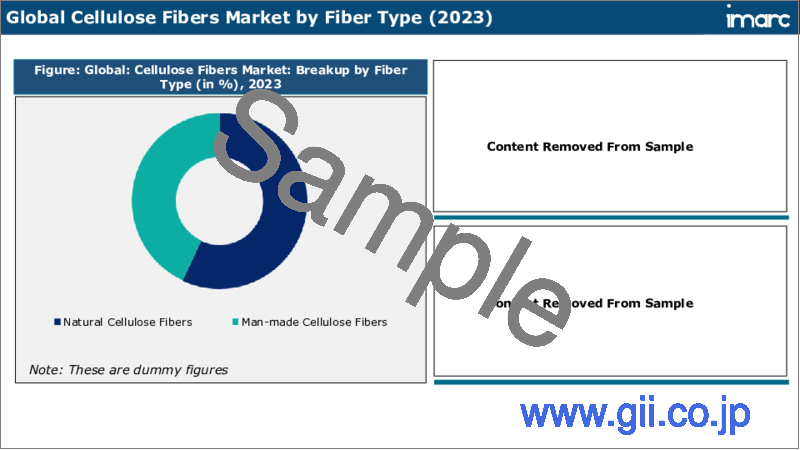|
|
市場調査レポート
商品コード
1518614
セルロース繊維市場レポート:繊維タイプ、用途、地域別、2024年~2032年Cellulose Fibers Market Report by Fiber Type (Natural Cellulose Fibers, Man-made Cellulose Fibers), Application (Apparels, Home Textiles, Medical and Hygiene, and Others), and Region 2024-2032 |
||||||
カスタマイズ可能
|
|||||||
| セルロース繊維市場レポート:繊維タイプ、用途、地域別、2024年~2032年 |
|
出版日: 2024年07月01日
発行: IMARC
ページ情報: 英文 148 Pages
納期: 2~3営業日
|
- 全表示
- 概要
- 図表
- 目次
世界のセルロース繊維市場規模は2023年に326億米ドルに達しました。今後、IMARC Groupは、市場は2032年までに632億米ドルに達し、2024年から2032年の間に7.4%の成長率(CAGR)を示すと予測しています。
セルロース繊維は、木材パルプを使用して製造される天然繊維または人工繊維を指します。また、植物の葉、木、樹皮のエステルやその他の植物由来の材料を使用して製造することもできます。その他の天然繊維は綿、ジュート、亜麻、麻、ラミーなどから得られるが、人工繊維には主にリヨセル、ビスコース、モダールなどがあります。これらの繊維は非常に軽量で、高い吸湿性と強度を示すため、繊維、家庭用繊維、バイオ複合材料、ポリマー複合材料、化学フィルターの製造に主に使用されています。
世界中で繊維産業が大きく成長していることが、市場の成長を促す主な要因のひとつです。さらに、環境意識の高まりが生分解性繊維の需要を促進しており、これも成長を促す大きな要因となっています。セルロース繊維は主に木材パルプを使用して製造され、肌に優しく、生分解性で環境に優しい性質を持つため、繊維産業で広く採用されています。さらに、セルロース繊維の機械的特性、生体適合性、生分解性を向上させるためのセルロースナノフィブリル(CNF)やセルロースナノクリスタル(CNC)の利用などの進歩とともに、カーテンや椅子張りなどの工業用繊維製品の製造に製品の利用が増加していることが、市場の成長にプラスの影響を与えています。石油化学製品の代わりに植物由来の原料の使用を促進する有利な政府政策の実施を含むその他の要因は、産業用途の拡大、原料の容易な入手、これらの繊維の費用対効果と相まって、市場をさらに牽引すると予測されます。
本レポートで扱う主な質問
- 2023年の世界のセルロース繊維市場の市場規模は?
- 2024~2032年の世界のセルロース繊維市場の予想成長率は?
- 世界のセルロース繊維市場を牽引する主な要因は?
- 世界のセルロース繊維市場に対するCOVID-19の影響は?
- 世界のセルロース繊維市場の繊維タイプ別内訳は?
- 世界のセルロース繊維市場の主要地域は?
- 世界のセルロース繊維市場の主要プレーヤー/企業は?
目次
第1章 序文
第2章 調査範囲と調査手法
- 調査の目的
- ステークホルダー
- データソース
- 一次情報
- 二次情報
- 市場推定
- ボトムアップアプローチ
- トップダウンアプローチ
- 調査手法
第3章 エグゼクティブサマリー
第4章 イントロダクション
- 概要
- 主要業界動向
第5章 世界のセルロース繊維市場
- 市場概要
- 市場実績
- COVID-19の影響
- 市場予測
第6章 市場内訳:繊維タイプ別
- 天然セルロース繊維
- 市場動向
- 主な種類
- 綿繊維
- 黄麻繊維
- 木質繊維
- その他
- 市場予測
- 人工セルロース繊維
- 市場動向
- 主な種類
- ビスコース繊維
- リヨセル繊維
- モダール繊維
- その他
- 市場予測
第7章 市場内訳:用途別
- アパレル
- 市場動向
- 市場予測
- ホームテキスタイル
- 市場動向
- 市場予測
- 医療と衛生
- 市場動向
- 市場予測
- その他
- 市場動向
- 市場予測
第8章 市場内訳:地域別
- 北米
- 米国
- カナダ
- アジア太平洋
- 中国
- 日本
- インド
- 韓国
- オーストラリア
- インドネシア
- その他
- 欧州
- ドイツ
- フランス
- 英国
- イタリア
- スペイン
- ロシア
- その他
- ラテンアメリカ
- ブラジル
- メキシコ
- その他
- 中東・アフリカ
- 市場動向
- 市場内訳:国別
- 市場予測
第9章 SWOT分析
- 概要
- 強み
- 弱み
- 機会
- 脅威
第10章 バリューチェーン分析
第11章 ポーターのファイブフォース分析
- 概要
- 買い手の交渉力
- 供給企業の交渉力
- 競合の程度
- 新規参入業者の脅威
- 代替品の脅威
第12章 価格指標
第13章 競合情勢
- 市場構造
- 主要企業
- 主要企業のプロファイル
- CFF GmbH & Co. KG
- China Bambro Textile(Group)Co. Ltd.
- Daicel Corporation
- Eastman Chemical Company
- Fulida Group Holdings Co. Ltd.
- Grasim Industries Ltd.
- Kelheim Fibres
- Lenzing AG
- Sateri Holdings Ltd.
- Shandong Helon Textiles Sci. & Tech. Co. Ltd.
- Tangshan Sanyou Xingda Chemical Fiber Co. Ltd.
- Zhejiang Fulida Co. Ltd.
List of Figures
- Figure 1: Global: Cellulose Fibers Market: Major Drivers and Challenges
- Figure 2: Global: Cellulose Fibers Market: Sales Value (in Billion US$), 2018-2023
- Figure 3: Global: Cellulose Fibers Market: Breakup by Fiber Type (in %), 2023
- Figure 4: Global: Cellulose Fibers Market: Breakup by Application (in %), 2023
- Figure 5: Global: Cellulose Fibers Market: Breakup by Region (in %), 2023
- Figure 6: Global: Cellulose Fibers Market Forecast: Sales Value (in Billion US$), 2024-2032
- Figure 7: Global: Cellulose Fibers (Natural) Market: Sales Value (in Million US$), 2018 & 2023
- Figure 8: Global: Cellulose Fibers (Natural) Market Forecast: Sales Value (in Million US$), 2024-2032
- Figure 9: Global: Cellulose Fibers (Man-made) Market: Sales Value (in Million US$), 2018 & 2023
- Figure 10: Global: Cellulose Fibers (Man-made) Market Forecast: Sales Value (in Million US$), 2024-2032
- Figure 11: Global: Cellulose Fibers (Apparels) Market: Sales Value (in Million US$), 2018 & 2023
- Figure 12: Global: Cellulose Fibers (Apparels) Market Forecast: Sales Value (in Million US$), 2024-2032
- Figure 13: Global: Cellulose Fibers (Home Textiles) Market: Sales Value (in Million US$), 2018 & 2023
- Figure 14: Global: Cellulose Fibers (Home Textiles) Market Forecast: Sales Value (in Million US$), 2024-2032
- Figure 15: Global: Cellulose Fibers (Medical and Hygiene) Market: Sales Value (in Million US$), 2018 & 2023
- Figure 16: Global: Cellulose Fibers (Medical and Hygiene) Market Forecast: Sales Value (in Million US$), 2024-2032
- Figure 17: Global: Cellulose Fibers (Other Applications) Market: Sales Value (in Million US$), 2018 & 2023
- Figure 18: Global: Cellulose Fibers (Other Applications) Market Forecast: Sales Value (in Million US$), 2024-2032
- Figure 19: North America: Cellulose Fibers Market: Sales Value (in Million US$), 2018 & 2023
- Figure 20: North America: Cellulose Fibers Market Forecast: Sales Value (in Million US$), 2024-2032
- Figure 21: United States: Cellulose Fibers Market: Sales Value (in Million US$), 2018 & 2023
- Figure 22: United States: Cellulose Fibers Market Forecast: Sales Value (in Million US$), 2024-2032
- Figure 23: Canada: Cellulose Fibers Market: Sales Value (in Million US$), 2018 & 2023
- Figure 24: Canada: Cellulose Fibers Market Forecast: Sales Value (in Million US$), 2024-2032
- Figure 25: Asia Pacific: Cellulose Fibers Market: Sales Value (in Million US$), 2018 & 2023
- Figure 26: Asia Pacific: Cellulose Fibers Market Forecast: Sales Value (in Million US$), 2024-2032
- Figure 27: China: Cellulose Fibers Market: Sales Value (in Million US$), 2018 & 2023
- Figure 28: China: Cellulose Fibers Market Forecast: Sales Value (in Million US$), 2024-2032
- Figure 29: Japan: Cellulose Fibers Market: Sales Value (in Million US$), 2018 & 2023
- Figure 30: Japan: Cellulose Fibers Market Forecast: Sales Value (in Million US$), 2024-2032
- Figure 31: India: Cellulose Fibers Market: Sales Value (in Million US$), 2018 & 2023
- Figure 32: India: Cellulose Fibers Market Forecast: Sales Value (in Million US$), 2024-2032
- Figure 33: South Korea: Cellulose Fibers Market: Sales Value (in Million US$), 2018 & 2023
- Figure 34: South Korea: Cellulose Fibers Market Forecast: Sales Value (in Million US$), 2024-2032
- Figure 35: Australia: Cellulose Fibers Market: Sales Value (in Million US$), 2018 & 2023
- Figure 36: Australia: Cellulose Fibers Market Forecast: Sales Value (in Million US$), 2024-2032
- Figure 37: Indonesia: Cellulose Fibers Market: Sales Value (in Million US$), 2018 & 2023
- Figure 38: Indonesia: Cellulose Fibers Market Forecast: Sales Value (in Million US$), 2024-2032
- Figure 39: Others: Cellulose Fibers Market: Sales Value (in Million US$), 2018 & 2023
- Figure 40: Others: Cellulose Fibers Market Forecast: Sales Value (in Million US$), 2024-2032
- Figure 41: Europe: Cellulose Fibers Market: Sales Value (in Million US$), 2018 & 2023
- Figure 42: Europe: Cellulose Fibers Market Forecast: Sales Value (in Million US$), 2024-2032
- Figure 43: Germany: Cellulose Fibers Market: Sales Value (in Million US$), 2018 & 2023
- Figure 44: Germany: Cellulose Fibers Market Forecast: Sales Value (in Million US$), 2024-2032
- Figure 45: France: Cellulose Fibers Market: Sales Value (in Million US$), 2018 & 2023
- Figure 46: France: Cellulose Fibers Market Forecast: Sales Value (in Million US$), 2024-2032
- Figure 47: United Kingdom: Cellulose Fibers Market: Sales Value (in Million US$), 2018 & 2023
- Figure 48: United Kingdom: Cellulose Fibers Market Forecast: Sales Value (in Million US$), 2024-2032
- Figure 49: Italy: Cellulose Fibers Market: Sales Value (in Million US$), 2018 & 2023
- Figure 50: Italy: Cellulose Fibers Market Forecast: Sales Value (in Million US$), 2024-2032
- Figure 51: Spain: Cellulose Fibers Market: Sales Value (in Million US$), 2018 & 2023
- Figure 52: Spain: Cellulose Fibers Market Forecast: Sales Value (in Million US$), 2024-2032
- Figure 53: Russia: Cellulose Fibers Market: Sales Value (in Million US$), 2018 & 2023
- Figure 54: Russia: Cellulose Fibers Market Forecast: Sales Value (in Million US$), 2024-2032
- Figure 55: Others: Cellulose Fibers Market: Sales Value (in Million US$), 2018 & 2023
- Figure 56: Others: Cellulose Fibers Market Forecast: Sales Value (in Million US$), 2024-2032
- Figure 57: Latin America: Cellulose Fibers Market: Sales Value (in Million US$), 2018 & 2023
- Figure 58: Latin America: Cellulose Fibers Market Forecast: Sales Value (in Million US$), 2024-2032
- Figure 59: Brazil: Cellulose Fibers Market: Sales Value (in Million US$), 2018 & 2023
- Figure 60: Brazil: Cellulose Fibers Market Forecast: Sales Value (in Million US$), 2024-2032
- Figure 61: Mexico: Cellulose Fibers Market: Sales Value (in Million US$), 2018 & 2023
- Figure 62: Mexico: Cellulose Fibers Market Forecast: Sales Value (in Million US$), 2024-2032
- Figure 63: Others: Cellulose Fibers Market: Sales Value (in Million US$), 2018 & 2023
- Figure 64: Others: Cellulose Fibers Market Forecast: Sales Value (in Million US$), 2024-2032
- Figure 65: Middle East and Africa: Cellulose Fibers Market: Sales Value (in Million US$), 2018 & 2023
- Figure 66: Middle East and Africa: Cellulose Fibers Market Forecast: Sales Value (in Million US$), 2024-2032
- Figure 67: Global: Cellulose Fibers Industry: SWOT Analysis
- Figure 68: Global: Cellulose Fibers Industry: Value Chain Analysis
- Figure 69: Global: Cellulose Fibers Industry: Porter's Five Forces Analysis
List of Tables
- Table 1: Global: Cellulose Fibers Market: Key Industry Highlights, 2023 and 2032
- Table 2: Global: Cellulose Fibers Market Forecast: Breakup by Fiber Type (in Million US$), 2024-2032
- Table 3: Global: Cellulose Fibers Market Forecast: Breakup by Application (in Million US$), 2024-2032
- Table 4: Global: Cellulose Fibers Market Forecast: Breakup by Region (in Million US$), 2024-2032
- Table 5: Global: Cellulose Fibers Market: Competitive Structure
- Table 6: Global: Cellulose Fibers Market: Key Players
The global cellulose fibers market size reached US$ 32.6 Billion in 2023. Looking forward, IMARC Group expects the market to reach US$ 63.2 Billion by 2032, exhibiting a growth rate (CAGR) of 7.4% during 2024-2032.
Cellulose fiber refers to a natural or artificial fiber that is manufactured using wood pulp. It can also be produced using esters of leaves, wood and barks of the plants and other plant-based materials. The other natural fibers are obtained from cotton, jute, flax, hemp and ramie, whereas artificial fibers majorly include lyocell, viscose and modal. These fibers are extremely light-weight and exhibit high moisture absorbency and strength, owing to which they are majorly used for manufacturing fabrics, home textiles, biocomposites, polymer composites and chemical filters.
Significant growth in the textile industry across the globe is one of the key factors driving the growth of the market. Furthermore, increasing environmental consciousness has facilitated the demand for biodegradable fabrics, which is acting as another major growth-inducing factor. Cellulose fibers are primarily manufactured using wood pulp, which is skin-friendly, biodegradable and environment-friendly in nature, owing to which they are widely adopted in the textile industry. Additionally, increasing product utilization for manufacturing industrial textiles, such as curtains and upholstery, along with advancements, such as the utilization of cellulose nanofibrils (CNFs) and cellulose nanocrystals (CNCs) to enhance the mechanical properties, biocompatibility and biodegradability of cellulose fibers, is creating a positive impact on the market growth. Other factors, including the implementation of favorable government policies promoting the use of plant-based sources in place of petrochemicals, coupled with expanding industrial applications, easy availability of raw materials, and cost-effectiveness of these fibers, are projected to drive the market further.
Key Market Segmentation:
IMARC Group provides an analysis of the key trends in each sub-segment of the global cellulose fibers market report, along with forecasts at the global, regional and country level from 2024-2032. Our report has categorized the market based on fiber type and application.
Breakup by Fiber Type:
Natural Cellulose Fibers
Cotton Fibers
Jute Fibers
Wood Fibers
Others
Man-made Cellulose Fibers
Viscose Fibers
Lyocell Fibers
Modal Fibers
Others
Breakup by Application:
Apparels
Home Textiles
Medical and Hygiene
Others
Breakup by Region:
North America
United States
Canada
Asia Pacific
China
Japan
India
South Korea
Australia
Indonesia
Others
Europe
Germany
France
United Kingdom
Italy
Spain
Russia
Others
Latin America
Brazil
Mexico
Others
Middle East and Africa
Competitive Landscape:
The competitive landscape of the industry has also been examined with some of the key players being CFF GmbH & Co. KG, China Bambro Textile (Group) Co. Ltd., Daicel Corporation, Eastman Chemical Company, Fulida Group Holdings Co. Ltd., Grasim Industries Ltd., Kelheim Fibres, Lenzing AG, Sateri Holdings Ltd., Shandong Helon Textiles Sci. & Tech. Co. Ltd., Tangshan Sanyou Xingda Chemical Fiber Co. Ltd., Zhejiang Fulida Co. Ltd., etc.
Key Questions Answered in This Report
- 1. What was the size of the global cellulose fibers market in 2023?
- 2. What is the expected growth rate of the global cellulose fibers market during 2024-2032?
- 3. What are the key factors driving the global cellulose fibers market?
- 4. What has been the impact of COVID-19 on the global cellulose fibers market?
- 5. What is the breakup of the global cellulose fibers market based on the fiber type?
- 6. What is the breakup of the global cellulose fibers market based on the application?
- 7. What are the key regions in the global cellulose fibers market?
- 8. Who are the key players/companies in the global cellulose fibers market?
Table of Contents
1 Preface
2 Scope and Methodology
- 2.1 Objectives of the Study
- 2.2 Stakeholders
- 2.3 Data Sources
- 2.3.1 Primary Sources
- 2.3.2 Secondary Sources
- 2.4 Market Estimation
- 2.4.1 Bottom-Up Approach
- 2.4.2 Top-Down Approach
- 2.5 Forecasting Methodology
3 Executive Summary
4 Introduction
- 4.1 Overview
- 4.2 Key Industry Trends
5 Global Cellulose Fibers Market
- 5.1 Market Overview
- 5.2 Market Performance
- 5.3 Impact of COVID-19
- 5.4 Market Forecast
6 Market Breakup by Fiber Type
- 6.1 Natural Cellulose Fibers
- 6.1.1 Market Trends
- 6.1.2 Major Types
- 6.1.2.1 Cotton Fibers
- 6.1.2.2 Jute Fibers
- 6.1.2.3 Wood Fibers
- 6.1.2.4 Others
- 6.1.3 Market Forecast
- 6.2 Man-made Cellulose Fibers
- 6.2.1 Market Trends
- 6.2.2 Major Types
- 6.2.2.1 Viscose Fibers
- 6.2.2.2 Lyocell Fibers
- 6.2.2.3 Modal Fibers
- 6.2.2.4 Others
- 6.2.3 Market Forecast
7 Market Breakup by Application
- 7.1 Apparels
- 7.1.1 Market Trends
- 7.1.2 Market Forecast
- 7.2 Home Textiles
- 7.2.1 Market Trends
- 7.2.2 Market Forecast
- 7.3 Medical and Hygiene
- 7.3.1 Market Trends
- 7.3.2 Market Forecast
- 7.4 Others
- 7.4.1 Market Trends
- 7.4.2 Market Forecast
8 Market Breakup by Region
- 8.1 North America
- 8.1.1 United States
- 8.1.1.1 Market Trends
- 8.1.1.2 Market Forecast
- 8.1.2 Canada
- 8.1.2.1 Market Trends
- 8.1.2.2 Market Forecast
- 8.1.1 United States
- 8.2 Asia Pacific
- 8.2.1 China
- 8.2.1.1 Market Trends
- 8.2.1.2 Market Forecast
- 8.2.2 Japan
- 8.2.2.1 Market Trends
- 8.2.2.2 Market Forecast
- 8.2.3 India
- 8.2.3.1 Market Trends
- 8.2.3.2 Market Forecast
- 8.2.4 South Korea
- 8.2.4.1 Market Trends
- 8.2.4.2 Market Forecast
- 8.2.5 Australia
- 8.2.5.1 Market Trends
- 8.2.5.2 Market Forecast
- 8.2.6 Indonesia
- 8.2.6.1 Market Trends
- 8.2.6.2 Market Forecast
- 8.2.7 Others
- 8.2.7.1 Market Trends
- 8.2.7.2 Market Forecast
- 8.2.1 China
- 8.3 Europe
- 8.3.1 Germany
- 8.3.1.1 Market Trends
- 8.3.1.2 Market Forecast
- 8.3.2 France
- 8.3.2.1 Market Trends
- 8.3.2.2 Market Forecast
- 8.3.3 United Kingdom
- 8.3.3.1 Market Trends
- 8.3.3.2 Market Forecast
- 8.3.4 Italy
- 8.3.4.1 Market Trends
- 8.3.4.2 Market Forecast
- 8.3.5 Spain
- 8.3.5.1 Market Trends
- 8.3.5.2 Market Forecast
- 8.3.6 Russia
- 8.3.6.1 Market Trends
- 8.3.6.2 Market Forecast
- 8.3.7 Others
- 8.3.7.1 Market Trends
- 8.3.7.2 Market Forecast
- 8.3.1 Germany
- 8.4 Latin America
- 8.4.1 Brazil
- 8.4.1.1 Market Trends
- 8.4.1.2 Market Forecast
- 8.4.2 Mexico
- 8.4.2.1 Market Trends
- 8.4.2.2 Market Forecast
- 8.4.3 Others
- 8.4.3.1 Market Trends
- 8.4.3.2 Market Forecast
- 8.4.1 Brazil
- 8.5 Middle East and Africa
- 8.5.1 Market Trends
- 8.5.2 Market Breakup by Country
- 8.5.3 Market Forecast
9 SWOT Analysis
- 9.1 Overview
- 9.2 Strengths
- 9.3 Weaknesses
- 9.4 Opportunities
- 9.5 Threats
10 Value Chain Analysis
11 Porters Five Forces Analysis
- 11.1 Overview
- 11.2 Bargaining Power of Buyers
- 11.3 Bargaining Power of Suppliers
- 11.4 Degree of Competition
- 11.5 Threat of New Entrants
- 11.6 Threat of Substitutes
12 Price Indicators
13 Competitive Landscape
- 13.1 Market Structure
- 13.2 Key Players
- 13.3 Profiles of Key Players
- 13.3.1 CFF GmbH & Co. KG
- 13.3.1.1 Company Overview
- 13.3.1.2 Product Portfolio
- 13.3.2 China Bambro Textile (Group) Co. Ltd.
- 13.3.2.1 Company Overview
- 13.3.2.2 Product Portfolio
- 13.3.3 Daicel Corporation
- 13.3.3.1 Company Overview
- 13.3.3.2 Product Portfolio
- 13.3.3.3 Financials
- 13.3.3.4 SWOT Analysis
- 13.3.4 Eastman Chemical Company
- 13.3.4.1 Company Overview
- 13.3.4.2 Product Portfolio
- 13.3.4.3 Financials
- 13.3.4.4 SWOT Analysis
- 13.3.5 Fulida Group Holdings Co. Ltd.
- 13.3.5.1 Company Overview
- 13.3.5.2 Product Portfolio
- 13.3.6 Grasim Industries Ltd.
- 13.3.6.1 Company Overview
- 13.3.6.2 Product Portfolio
- 13.3.6.3 Financials
- 13.3.6.4 SWOT Analysis
- 13.3.7 Kelheim Fibres
- 13.3.7.1 Company Overview
- 13.3.7.2 Product Portfolio
- 13.3.7.3 Financials
- 13.3.8 Lenzing AG
- 13.3.8.1 Company Overview
- 13.3.8.2 Product Portfolio
- 13.3.9 Sateri Holdings Ltd.
- 13.3.9.1 Company Overview
- 13.3.9.2 Product Portfolio
- 13.3.10 Shandong Helon Textiles Sci. & Tech. Co. Ltd.
- 13.3.10.1 Company Overview
- 13.3.10.2 Product Portfolio
- 13.3.11 Tangshan Sanyou Xingda Chemical Fiber Co. Ltd.
- 13.3.11.1 Company Overview
- 13.3.11.2 Product Portfolio
- 13.3.12 Zhejiang Fulida Co. Ltd.
- 13.3.12.1 Company Overview
- 13.3.12.2 Product Portfolio
- 13.3.1 CFF GmbH & Co. KG






